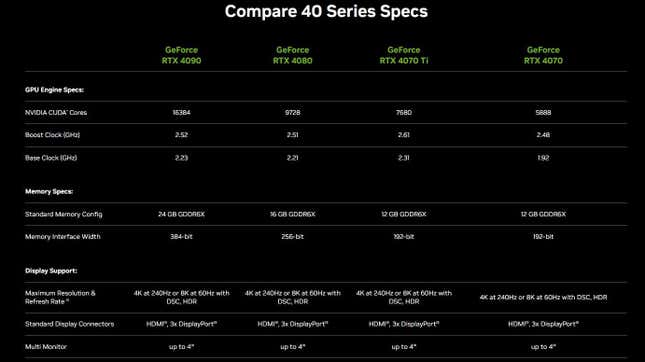
Last year Nvidia launched bully, expensive power guzzlers with the GeForce RTX 4080 and 4090 graphics cards and brushed aside the only real budget option via its own confusing naming conventions. Compromising performance in exchange for big savings is back on the table today thanks to the 4070, a $600 card that promises lots of bells and whistles if you’re willing to sacrifice 4K graphics.
Nvidia calls the GeForce RTX 4070, which goes on sale April 13, the “ideal GPU” for those who want to play the latest blockbuster games at 1440p resolution, a respectable midpoint between standard HD and 4K. The company says it can hit that benchmark while still supporting ray tracing, DLSS 3, and high frame rates. “The GeForce RTX 4070 with DLSS 3 is 1.7x faster on average than the last-gen RTX 3070 Ti with DLSS 2,” it said in an April 12 announcement. “It’s also an average of 20% faster in traditional games and reduces average gaming power consumption by 23%.”

Digging a little deeper into the comparisons, the 4070 costs over $200 less than the next cheaper option, the GeForce RTX 4070 Ti, and is still $100 less than the last-gen GeForce RTX 3080. At higher resolutions, the 3080 still seems to have an edge, but early reviews suggest Nvidia’s latest budget option will give gamers more bang for their buck if they’re willing to settle for 1440p. It’s also the smallest 4000-series card yet, which might be a relief for anyone not looking forward to upgrading their PC case to house Nvidia’s existing behemoths.
When the company first unveiled the 4090 and 4080 cards last year, CEO Jensen Huang said it was $1,200 the new normal for high-end gaming GPUs. To make matters worse, a “cheaper” $900 12GB RTX 4080 option was canned right away, with Nvidia launching the SKU just weeks later, given that while it’s considered too “Confusing” to have two different GPUs, both using the “RTX 4080” name. It eventually reappeared in January in the form of the weaker RTX 4070 Tibut the new RTX 4070 base card lowers the price point even further.
Graphics card prices surged at the start of the pandemic due to supply shortages and the surge in crypto mining operations. Both problems have subsided, but prices remain high as manufacturers push the envelope. For now, at least, the lag in demanding new blockbuster games has given gamers some breathing room in this hardware cycle. We’ll see how long that lasts with starfield and other big games on the horizon.



